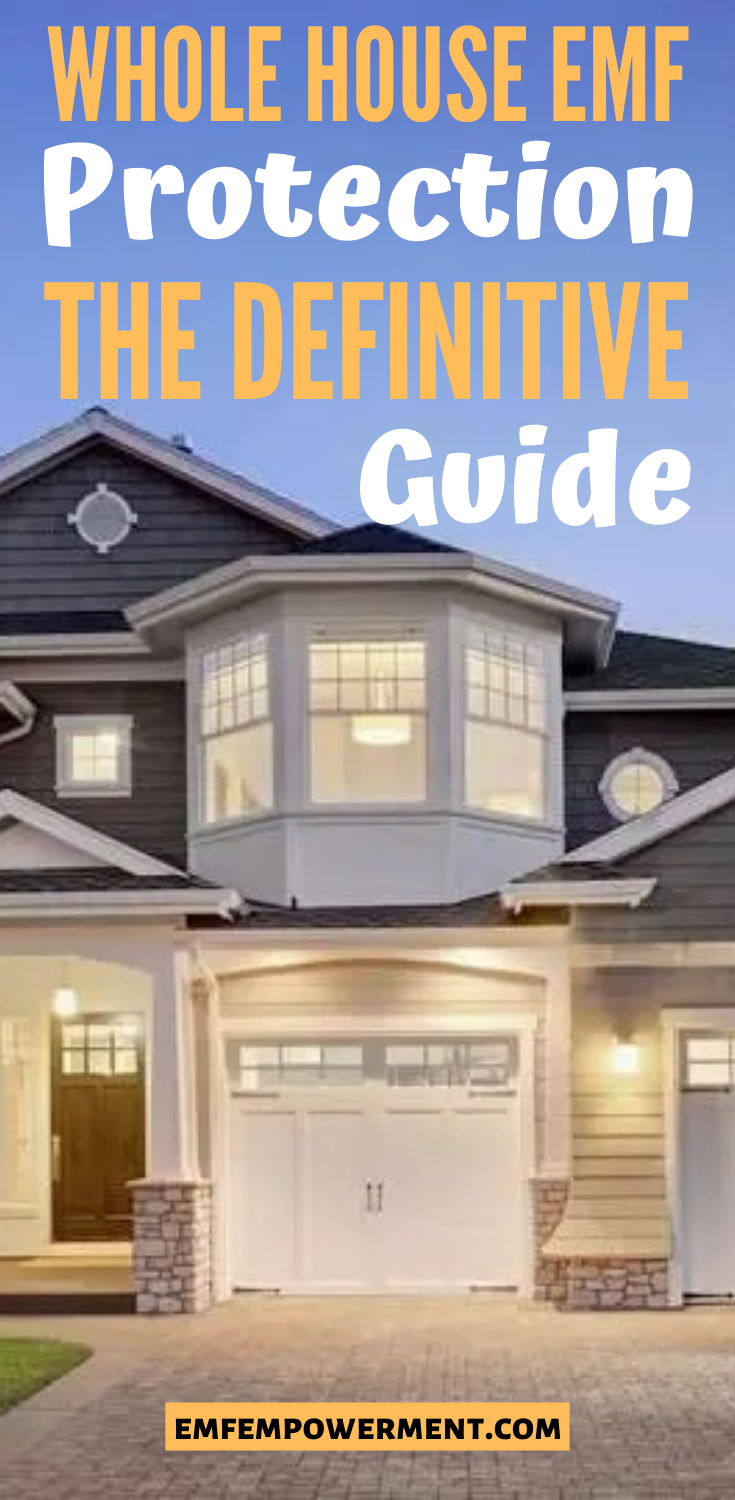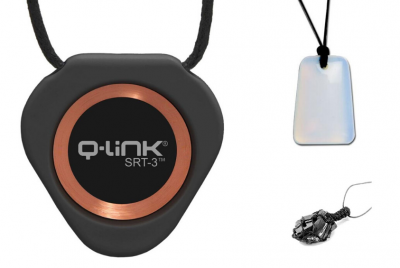When worn correctly, both Bluetooth and wired earbuds offer a lightweight and comfortable way to listen…
Whole House EMF Protection: The Definitive Guide

*We may earn a commission for purchases made using our links. Please see our disclosure to learn more.
If you’re a visitor to this site, you’re probably familiar with the potential side effects of EMF radiation exposure. And if you know the risks, there’s a good chance you now want to take action to protect yourself and your family.
Lowering your home’s EMF levels
Once you know about the risks associated with EMF radiation, the next step is to take action. The goal should be to reduce your EMF exposure at the places you spend the most time, and for many of us, that includes the home.
Reducing your home’s EMF levels can be a daunting task. It seems that nearly everything produces some form of EMF radiation, whether it’s your microwave or your smart meter — do you really need to get rid of all of it?
No, you don’t. There are things you can do to lower your home’s EMF levels without forgoing modern conveniences all together. That’s why we’ve created this guide — to break down exactly what you can do to help lower your home’s EMF radiation levels in each room of your house.
Whole house
The following tips will help lower the EMF radiation levels in your entire home. If possible, take these steps first to reduce your home’s base radiation levels. Next, we’ll discuss what you can do in each room to further decrease your levels.
Home inspection
It’s hard to protect your home if you don’t know exactly what is generating EMF radiation. While you can determine this yourself with an EMF meter, it can sometimes be difficult to discern the exact source of the radiation. That’s where an EMF inspector comes in. EMF inspectors have special, professional-grade tools, such as spectrum analyzers, that are much more sensitive to radiation than a consumer-grade meter.
The job of an EMF inspector is to thoroughly examine your home for all potential sources of EMF radiation. An EMF inspector goes through your home from top to bottom to identify all areas of concern. From there, they can help you develop a customized plan of attack for reducing your home’s overall EMF levels. If you’re unsure of what steps to take, a home inspection is a great place to start.
Although an inspection can be an investment, many people find that it’s well worth the cost. Once you identify problem areas in your home, you can start to fix them.
Wired internet
One thing that will drastically reduce the EMF levels of most homes is to switch from wireless to wired internet. It may seem like moving backward, but wired internet is actually faster, more reliable, and more secure than a wireless connection. And, as an added bonus, it produces minimal EMF radiation.
WiFi internet, on the other hand, generates a great deal of RF-EMF radiation, and it broadcasts this all throughout your home. Signal boosters, while useful for extending your WiFi’s range, can make matters worse. If at all possible, turn the WiFi off on your wireless router and switch to a wired connection. This may entail laying down a connection for each room and device in your home, but the installation really is the hardest part. Once it’s done, you can enjoy a far superior connection with less EMF produced.
Incandescent bulbs
One thing you may not think about as a major EMF source is the light bulbs in your home. LED and CFL light bulbs, however, create a great deal of ELF-EMF radiation, in part because of the dirty electricity these bulbs produce. If you’re trying to cut down on your home’s EMF radiation levels, one easy change is to use incandescent bulbs.
Incandescent bulbs are less energy-efficient than CFLs or LEDs. That’s actually a good thing when it comes to EMF radiation because energy-efficient devices do not use all the electricity supplied to them, resulting in dirty electricity. A less energy-efficient light bulb produces less dirty electricity and therefore less ELF-EMF radiation.
Dirty electricity filters
As mentioned earlier, dirty electricity is the byproduct when more electricity is created than is used. This tends to happen a lot with energy-efficient appliances and devices, as well as with solar panel batteries. Dirty electricity is a form of ELF-EMF radiation, and it is present in most homes at some level.
Dirty electricity filters are typically plug-in devices that must be installed on each circuit of your home. Once plugged in, the filter helps to absorb and neutralize dirty electricity on that circuit. Some filters can be plugged into your home’s main circuit breaker, filtering electricity for the entire home. The two major brands of dirty electricity filters are Greenwave and Stetzerizer. Both are similar in design and function, although Greenwave receives slightly better reviews.
You can measure the amount of dirty electricity in your home with a dirty electricity meter. Both Greenwave and Stetzerizer manufacture their own dirty electricity filters. Ideally, take a measurement before and after installing your filters in order to note the difference. You should see a notable improvement post-installation.
Outdoor radiation
Radiation from outside of the home can easily impact the levels inside the home, too. Smart meters, nearby WiFi signals, cell towers, and power lines are all significant sources of EMF radiation. While it may seem like these things are outside of your control, you can take certain steps to minimize your exposure.
Smart meter cover
Smart meters have streamlined the process of meter reading, and for that reason, many municipalities swear by them. If your city isn’t using them already, there’s a good chance they’re planning on switching. Smart meters allow utility workers to digitally scan your meter as they drive by, eliminating the need to actually enter your property.
While smart meters are convenient, they also produce an astronomical amount of EMF radiation. They are constantly sending and receiving signals back to a transmitter, the end result of which is a very high amount of RF-EMF radiation, specifically.
To counteract this, you can install a smart meter cover. While there are different types, most act as Faraday cages, helping to absorb and reflect radiation. One popular smart meter cover on the market is Smart Meter Guard’s RF Radiation Shield. The manufacturer claims that it reduces RF-EMF exposure from a smart meter by up to 99%. The cover is installed by placing it over your smart meter and fastening a screw to hold it in place. Like most smart covers, Smart Meter Guard’s RF Radiation Shield comes with a small gap to allow the signal to pass through — this is so the meter can still be used by the utility company.
EMF paint
Going back to smart meters, a smart meter cover is effective at blocking the radiation that is broadcasted in front of the meter. If you want to protect behind the meter, consider painting the interior wall with EMF paint. This will stop the signal from penetrating your home’s walls and entering your living space. EMF paint is also useful if you notice that your home is in close proximity to a neighbor’s WiFi signal or a cell tower, as well. If you want to go the distance, you could paint your entire home to achieve total EMF protection.
There are several types of EMF paint on the market. One of the more popular brands out there is YShield. While it is on the pricier side, YShield’s paint is highly effective at blocking EMF radiation — up to 99.995% after two applications. Like most EMF paint, YShield is conductive and therefore requires grounding by a licensed electrician. Each wall that is painted requires its own grounding unit, for best results.
EMF shields and fabrics
If you want something a little easier than painting your walls, you could also line them with an EMF resistant fabric. These fabrics are designed to absorb or reflect EMF radiation so it doesn’t penetrate through. Simply hang the fabric on any interior walls of your home that are facing a source of EMF radiation. The fabric will prevent EMF radiation from passing through and into your home.
If you decide to go the fabric route, TitanRF’s Faraday Fabric is reasonably priced. The manufacturer claims that it provides military-grade resistance against RF radiation in particular. This is one thing to be mindful of — the product will protect against smart meters, WiFi signals, and cell towers, but not against the ELF-EMF radiation produced by a power line.
Bedroom radiation
When it comes to EMF protection, the most important room of the home is the bedroom. Not only do we tend to spend a great deal of time in there, but sleep is when the body restores itself from damage. Creating an EMF-free space is critical because it helps the body recover from the radiation that it is exposed to during the day.
Bed canopies
EMF protection canopies offer the ability to shield your bed from harmful radiation, helping to protect you while you sleep. These canopies are typically draped over the entire bed, although some protect mainly around the head area. Bed canopies are especially beneficial if you need to sleep with your cell phone nearby you, as they allow you to stay in close proximity without being exposed to harmful radiation.
One highly reviewed bed canopy is UrGrading’s Silver Coated Mesh Anti-Radiation Canopy. Made from 100% silver coated mesh and built big enough for a king-sized bed, UrGrading’s canopy is also cheaper than most other EMF canopies on the market.
EMF blankets
On a related note, another worthwhile investment to help protect you while you sleep is an EMF blanket. Whether you’re unable to afford a bed canopy, or you just want added protection, EMF blankets offer shielding from EMF radiation while you sleep.
While many popular EMF blankets are designed primarily for babies and the bellies of pregnant women, some are also made for full-sized adults. DefenderShield makes a great adult EMF blanket that is advertised as being 99.9% effective at blocking EMF radiation. Or, if you’re in the market for something small, SYB makes a great EMF protection baby blanket made from hypoallergenic cotton flannel.
Home office
Think for a moment about the items that are in your home office. You may have a laptop computer, a router, a phone, and other electronic devices. Many of these devices produce some form of EMF radiation, so let’s discuss what steps you can take to protect yourself.
WiFi Router Guard
While your best bet is to switch to wired internet, as we discussed earlier, that is not feasible for everyone. If your home can’t go wireless, at least consider installing a WiFi router guard. Similar to a smart meter cover, WiFi router guards act as a Faraday cage, preventing EMF radiation from being broadcast into your home while still allowing a WiFi signal to penetrate through the cage.
Router Guard makes a highly rated product that won’t break the bank. The device looks like a small cage, and you simply place your router inside of it, snaking the cords through the holes provided. Just keep in mind that the box must be able to physically contain your router. Router Guard comes in two sizes – standard and large. Be sure to measure your router before making a purchase so you know which size to buy.
Laptop radiation pad
If you’re a regular laptop user, take note of the fact that laptops generate a whole lot of EMF radiation. Placing a laptop directly on your lap exposes your reproductive organs to an onslaught of EMF radiation. Even placing the laptop on a table isn’t ideal — EMF radiation is still broadcast through the table and towards your lap.
To protect yourself, use a laptop radiation pad. DefenderShield’s DefenderPad is an excellent and inexpensive option designed for laptops up to 17 inches. All you need to do is place the laptop on the pad, and use it as you normally would. The pad will help prevent EMF radiation from reaching your lap.
Phones
If you use a cordless phone in your home office, consider switching to either a corded phone or one that produces less EMF radiation. Cordless phones generate a great deal of EMF radiation as the receiver communicates to the base station. When you use the phone, this radiation is broadcast directly through your skull, potentially leading to side effects such as glioma, a serious and rare form of brain cancer. If you must stay cordless, consider using Gigaset’s low EMF cordless phone. This option only communicates to the base station when absolutely necessary, leading to less EMF production.
Alternatively, if you primarily use your cell phone, you may want to invest in an RF-shielding phone case. One option is SYB’s plain black phone case. While it may look plain, it can shield you from up to 99% of EMF radiation– at least on one side of the phone. You’ll still want to use a wired headset when making or receiving phone calls.
The Kitchen
The kitchen may not seem like an obvious source of EMF radiation, but the reality is that appliances generate a great deal. This is especially true of energy efficient appliances, because of the dirty electricity they produce. Additionally, smart appliances have become more popular in recent years. These devices usually rely on WiFi or Bluetooth, and as such, they tend to create a great deal of RF-EMF radiation.
Appliances
Unfortunately, they have yet to make a Faraday cage for your fridge or smart oven. A lot of reducing appliance radiation is picking appliances that don’t produce much radiation. Older appliances tend to be safer, at least when it comes to EMF radiation. Another thing to be mindful of is how you actually use the appliance.
Take a microwave, for example. If you stand close to the microwave while it is in use, you will be exposed to a significant amount of EMF radiation. If you stand at least ten feet away, this number drops substantially. Unplugging appliances when they aren’t in use and staying away from smart appliances that use WiFi is your best bet for reducing kitchen radiation. A dirty electricity filter on the kitchen circuit is a must, as well.
Living room
The living room is where we tend to gather, hang out, and relax. As technology has advanced, living rooms have followed suit. They often contain television sets, video game consoles, entertainment centers, and sometimes computers, phones, and wireless routers.
To reduce radiation in the living room, try to stay away from smart appliances such as WiFi-enabled TV sets. If possible, provide a hard wire for your video game consoles, and stay away from wireless game controllers. Even your TV’s remote control can be a producer of EMF radiation, so don’t be afraid to change the channel using the TV set instead of the controller, as well.
Lifestyle changes
You can further reduce quite a bit of your home’s EMF levels (or at least make yourself less susceptible to their harmful effects,) by making simple and inexpensive, or free, lifestyle changes. Sometimes these steps are a bit easier to take than some of the more drastic steps listed above. If you’re looking to start small, consider making one or more of the following changes to your daily routine.
Turn off your phone
If you keep your phone next to your bed at night to charge, consider shutting it off or at least putting it in airplane mode. If your phone must be on, aim to keep it a minimum of six feet from your bed. This is because phones produce a huge amount of EMF radiation, and, as mentioned earlier, the goal is to reduce your EMF exposure at night as much as possible.
Go dark
If you can’t switch to wired internet, at least try shutting your WiFi off when it’s not in use. By turning your WiFi off at night when your household is asleep, you will significantly cut down on your home’s overall EMF levels. In addition to going dark at night, you may also want to purchase a WiFi router guard. These devices help absorb some of the EMF radiation produced by your WiFi router. If wireless is your only option, a router guard can at least help lower your risk of exposure.
Take supplements and herbs
Supplements and herbs help boost the body’s natural defenses and protect against EMF-related illnesses. Some supplements and herbs that are particularly beneficial against EMF radiation are reishi, ginseng, turkey tail, and Vitamin C. Each offers its own unique ability to protect against the various health defects associated with EMF exposure.
While supplements and herbs won’t help cut down on your home’s overall radiation levels, they will help better prepare your body for radiation exposure.
EMF meter
Before and after making any adjustments, it can be helpful to first take a reading with a high-quality EMF meter. The purpose of this is to verify that the changes you made actually lowered your home’s EMF levels. EMF meters aren’t completely necessary, but they can be quite useful.
A good EMF meter should be capable of detecting all forms of EMF radiation, including ELF and RF-EMF. Some cheaper models can only detect EMF in the RF range, which isn’t helpful if you’re trying to sniff out lower frequencies. One great option is the TriField TF2. The TF2 can easily detect electric, magnetic, and RF radiation. Although it’s a bit higher priced than some other EMF meters, the TF2 offers reliability and accuracy.
Final thoughts
Taking steps to protect your home and family from EMF exposure is well worth the effort it requires. Although it may seem overwhelming at first, making changes one step at a time will eventually have huge results. Documenting your progress along the way with an EMF meter can help put into perspective how each change you make really does impact your home’s levels, too.
Although the advice in this guide can’t replace a plan from a certified EMF inspector, it can give you a good idea of some things you can do to help safeguard your home. Even just changing one or two things — for example, switching to wired internet and incandescent bulbs — can have a dramatic impact.




